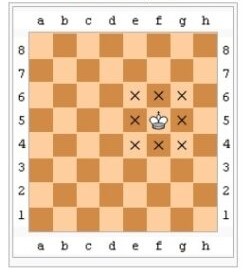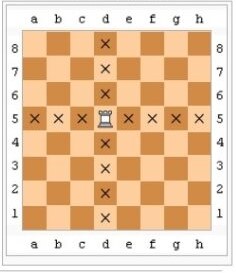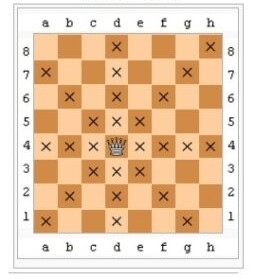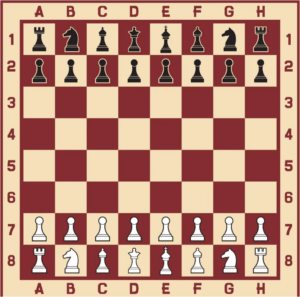Chess is an intellectual game that allows you to not only have fun with your friends, but also to engage your mind, delve into a game that reveals your skills, and create competitive situations where everyone wants to win. To play chess successfully, you must first understand the rules, the names of the pieces, and the most important moves. Continue reading to learn about the chess rules.
Names of Chess Pieces and Moves
To understand the game of chess, you must first become familiar with the pieces and their possible moves. Chess is made up of six different pieces, totaling 16 in the set: a king, queen, two rooks, two knights, two bishops, and eight pawns.
King’s Moves – this piece can move to any adjacent square if they are not under attack by the opponent. The king is the only piece that cannot move to a square that is directly attacked by the opponent.

Rook’s Moves – a rook can move an infinite number of squares in both vertical and horizontal directions. The exception is made during casting*.

Bishop’s Moves – a bishop can move an infinite number of squares diagonally.

Queen’s Moves – the queen is capable of moving in both the rook and bishop trajectories. It has the ability to move an unlimited number of squares vertically, horizontally, or diagonally.

Knight’s Moves – the knight may move two squares away from him, either horizontally or vertically, with one additional move following the first two, either vertically or horizontally. The horse’s gait is similar to the letter “L,” which can be turned at any angle.

Pawn Moves – the most difficult piece to move on the chessboard. A pawn can move two squares forward from its starting position (if they are not occupied), but it is the only piece in chess that cannot move backward. Notably, pawns capture opponent’s pieces in a different way than regular moves: pawns capture pieces diagonally in front of them.

Pawns can make two special moves: turning** and capture while passing***.
Special Chess Moves
* Castling – is the simultaneous movement of the king and rook. The purpose of castling is to strengthen the king’s position. Castling is classified into two types: short and long. During a game, only one castling per player is permitted – one for you and one for your opponent.
Casting is permitted if the king has not yet moved from his current position and no moves have been made with the rook. There can’t be any other pieces between the king and the rook, the king can’t be checked, and the squares the king should move through during casting can’t be controlled by the opponent, or he’ll be checked.
** Turning – when the pawn reaches the eighth horizontal and the opponent’s pawn reaches the first. The pawn must be replaced with the same suit: knight, bishop, the rook or queen. It is forbidden to place a king or nothing at all.
*** Capture while passing – If the opponent’s pawn moves two squares further after completing its move, lands to the right or left of the opponent’s pawn – with the next move, allow the pawn to capture its opponent by leaving the permitted straight path and moving into the opponent’s vertical.
Rules of Chess
Chess’s fundamental goal is to checkmate your opponent’s king. Which means the king is under attack and has no legal move to escape the danger. If neither player achieves this, the game ends in a tie.
Even if you’ve never played chess, you’ve probably heard words like “check” and “checkmate.” In chess, “check” refers to when your opponent’s king is under direct attack, and “checkmate” refers to when your opponent’s king is under check and cannot escape capture.
There are three ways to defend against checkmate: 1) capturing the checking piece, 2) blocking the check with another piece (except for a pawn or knight check), 3) moving the king to a safe square.
Chess rules that are most commonly used in competitions but are also followed by enthusiasts:
- If a player touches a piece, they must move it if the move is legal, unless no legal moves are possible.
- Once a legal move is completed and the hand is removed from the piece, the move cannot be retracted.
- If the player’s move is not permitted by the rules, he must return the piece and proceed with the same piece with which he performed the maneuver.
Arrangement of pieces on the chessboard.
All eight pawns are placed on the second row. Rooks are placed at the corners of the first row, followed by knights, bishops, and, finally, the king and queen in the center of the first row.
F.A.Q
Who makes the first move in chess?
The game is started by white.
Can a pawn move backward in chess?
No, pawns only move forward. There is an exception when a pawn reaches the opposite side of the board – it can be replaced by another piece, after which it can move as usual.
Can checkmate occur without a check?
No, declaring checkmate means the game is over, and there must first be a check situation.
What’s the best opening move in chess?
Legendary chess player Bobby Fischer believed that moving a pawn to 1. e4 is the best opening move. Generally, there’s no single best opening move, it depends on your subsequent tactics, but controlling the center of the board is crucial.
How long was the longest chess game?
In 1989, Ivan Nikoli and Goran Arsovi played a game that required 269 moves. It lasted more than 20 hours and ended in a tie.
Rules of other games
We also invite board game enthusiasts to learn the rules of Texas Hold’em poker, checkers, and roulette. For those who like active leisure time or want to learn more – about the rules of American football, darts, and football.



